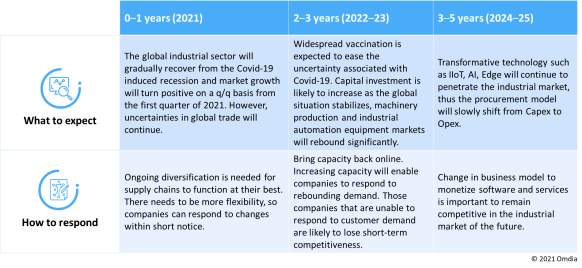Omdia view
Summary
The COVID-19 pandemic and geopolitical uncertainty have made 2020 a challenging year for the global economy and the industrial markets. Omdia’s latest research suggests the global machinery production and industrial automation equipment markets are forecast to contract by 12.4% and 7.1% in 2020, respectively. The future of the industrial markets, and the strength of the recovery from COVID-19, will be influenced by several key trends and cutting-edge technologies.
Figure 1: 2021 and beyond
 Source: Omdia
Source: Omdia
Five trends to watch in 2021
Reshoring and supply chain diversification
When the COVID-19 pandemic hit, governments around the world started to recognize the risk of relying on China’s manufacturing industry across all technology sectors, especially within automotive, medical equipment, electronics components, and raw materials. The pandemic has resulted in supply difficulties for US manufacturing, leading the US government to actively encourage companies to bring manufacturing back home through tax incentives. The Japanese government is also subsidizing Japanese companies to shift manufacturing out of China and into Southeast Asia or Japan.
Additionally, the trade war between the US and China has elevated the rate of US companies’ reshoring operations to North America. As a result, many companies may consider the option more seriously. Some surveys suggest that most US companies with production facilities or supply chains in China do not plan to relocate them. However, reshoring is inevitable over the long term. There will at least be a shift from China to other Asian countries, which is already happening and will continue.
Worldwide manufacturing seems to be shifting from offshoring to reshoring or nearshoring. The global trade openness index indicates the dynamics of global trade. The global reshoring trend is not definite, but China has certainly been diversified by overseas manufacturers. According to Kearney’s China Diversification Index, China’s share in US import value from Asia has declined from 67 in 1Q18 to 56 in 4Q19. This equates to roughly $31 billion in import value that has shifted away from China. The main beneficiary from the shift away from China is Vietnam, which absorbed almost 50%. Vietnam exported an additional $14 billion to the US in 2019, compared to 2018.
In the industrial automation equipment market, reshoring may take more time to occur, but Omdia expects reshoring and supply chain diversification to continue in 2021 as manufacturers aim to stay competitive in the industrial market.
Cloud and Edge
The COVID-19 pandemic has caused a downturn in investment in the automation sector. However, it has also increased focus around IIoT applications such as remote monitoring and operations. The mid-term effect is projected to be an investment acceleration in digital transformation that will benefit edge computing.
The growth of new technologies, alongside customer demand for more open solutions, will shake up automation design. Technologies used in enterprise IT, such as virtual machines and containers, are being introduced to operational technology (OT). Amongst other benefits, these solutions enable the decoupling of OT software from hardware. This shift is leading some automation suppliers to introduce software defined automation.
Omdia expects IT vendors to continue to build-out hardware and software solutions supporting edge computing for OT, as part of a hybrid edge-cloud model. However, the mix of different approaches to analytics is likely to hinder the market in the short-term. Industry consolidation around open standards is hindered by plethora of competing approaches, confusing end-users and reducing the uptake of new technology.
Software and services monetization
COVID-19-related headwinds have caused cuts in capital expenditure (Capex) in the short-term. Most of the world economy went into strict lockdowns when COVID-19 first hit, which impacted the manufacturing sectors. When production lines are running at reduced capacity, or idling, it is a good time for companies to consider restructuring their supply chain, digitally transforming the current manufacturing process, or upgrading their system and equipment. This would ensure companies remain competitive, and also allow them to adhere to new standard operating procedures (SOPs), including social distancing on the production floor, as they adapt to the new normal in a post-COVID-19 world.
Omdia is expecting the shift in business and procurement models in the industrial sectors to continue accelerating in 2021. Traditionally, the procurement model is one of Capex, supported by operating expenditure (Opex). End-users purchase equipment for a new project using Capex, whilst Opex will be spent for subsequent maintenance and services. Procurement is expected to gradually transition to an Opex-only model.
It is expected that end users will spend more on software and services for several reasons:
- Amid the recovery from the pandemic-induced recession, end users in more cost-sensitive regions and industries will spend more on repairs and maintenance services to prolong the lifespan of their machinery as much as possible, as capex budgets are reduced in the short-term.
- In order to adapt to the new normal in the post-pandemic environment, end users will continue to upgrade their existing machines, platforms, and processes in a bid to gain competitive advantage.
- The adoption of transformative technology will the key enabler of the software and services market. This includes connectivity between automation devices, communication between the enterprise and field levels of an organization, or even the implementation of augmented reality (AR) for training purposes in the factory floor.
Automation and robotics
During the COVID-19 pandemic, end users in discrete industries started to realize the importance of remote intelligence and automation to reduce reliance on the human workforce. In addition to common production problems such as rising labor costs and labor shortages, there are also new problems in the manufacturing industry such as ensuring production safety, adhering to new processes and procedures introduced for COVID-19, and avoiding crowded production lines.
Collaborative robots (cobots), automated guided vehicles (AGV), autonomous mobile robots (AMR), intelligent logistics, and robotic sorting systems are likely to see high levels of demand in 2021. These robotic and automation systems are expected to grow along with the recovery in logistic, warehousing, packaging, and semiconductor sectors.
Green and sustainability
Industrialization has long been one of the significant contributors to environmental pollution. Energy efficiency and sustainability will be the key focus in the industrial markets as governments around the world are committed to combat pollution issues.
Local climate policy and the accessibility of green energy will become important factors for OEMs and enterprises when determining where to locate new manufacturing facilities. For instance, Apple, Facebook, and other technology groups seek to shift their global supply chains to 100 per cent renewable power. As a result, component suppliers that are involved in the supply chains are under pressure to erase the carbon footprint of their manufacturing facilities. Therefore, government development plans and accessibility to renewable energy in a country are crucial to attract foreign direct investment (FDI) and setup manufacturing bases.
The global industrial automation equipment market is mainly regulated by the Minimum Energy Performance Standard (MEPS) legislation. New legislations in 2021 and beyond state:
- All low-voltage motors sold to reach an IE3 minimum standard and will no longer allow the exceptions on sales of IE2 motors paired with a low-voltage drive beginning in July 2021.
- Beginning on June 1, 2021, LV motors sold in mainland China will have to meet an IE3 minimum energy efficiency standard.
- Beginning in July 2023, all motors sold between 75kW and 200kW will be required to meet IE4 minimum efficiency.
Regional shifts to higher-efficiency systems are currently taking place in all three major regions and the trend will continue in 2021 and beyond.
Appendix
Further reading
Reshoring and diversification: Who are the real winners in a post-COVID-19 world? (August 2020)
The Chinese market landscape of AGV/AMR after COVID-19 (December 2020)
Author
Joanne Goh, Senior Analyst, Manufacturing Technology Hardware
Peter Taylor, Research Manager, Manufacturing Technology Hardware


